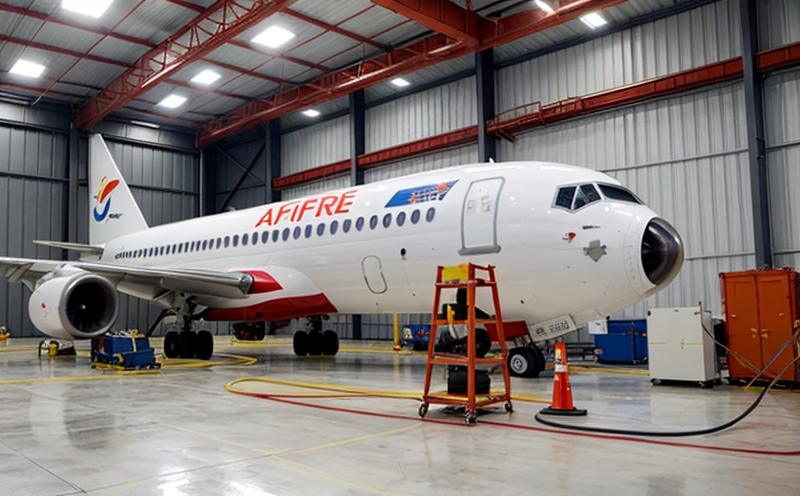FAA Certification Testing for Aircraft Fire Safety
In the aerospace industry, fire safety is paramount to ensure passenger and crew safety. The Federal Aviation Administration (FAA) mandates rigorous testing to certify that aircraft are safe from fire hazards. This service involves comprehensive testing to meet FAA certification requirements for materials used in aircraft interiors and structural components.
The process starts with understanding the specific materials used in different parts of the aircraft, such as upholstery, insulation, wiring systems, and other combustible elements. Each material must pass stringent tests to ensure it does not contribute to fire ignition or propagation under realistic operational conditions.
FAA certification testing typically involves several stages:
- Material Flammability Testing: This includes understanding the material's flame spread index, smoke density, and heat release rate. Materials must comply with standards such as ASTM E662 or UL 94.
- Structural Integrity under Fire Conditions: Tests are conducted to determine how structural components behave when exposed to fire. These tests may involve simulating real-world scenarios using equipment like the Cone Calorimeter (EN 13501-1).
- Smoke and Toxic Gas Emissions: Evaluating the amount of smoke and toxic gases produced by materials under fire conditions is critical. This helps in assessing the potential health risks to passengers.
For R&D engineers, this testing ensures that new materials or modifications are safe for integration into aircraft designs. Quality managers rely on these tests to ensure compliance with FAA regulations and standards, while procurement teams use the results to select suppliers who meet stringent fire safety requirements.
The significance of FAA certification cannot be overstated. It not only protects passengers but also ensures that airlines can continue operating safely, meeting international aviation standards. The process involves detailed documentation and reporting, which must adhere to FAA guidelines and international standards like EN 13501-1 and ASTM E603.
The testing apparatus used includes sophisticated equipment such as the Cone Calorimeter for evaluating heat release rates, oxygen index testers, and smoke density meters. These tools provide precise data that helps in refining materials and processes to meet the highest safety standards.
Customer Impact and Satisfaction
The FAA certification process is a critical step for aerospace companies aiming to introduce new aircraft models or modify existing ones. By ensuring all components pass rigorous fire safety tests, these companies can:
- Avoid Legal and Regulatory Issues: Compliance with FAA standards minimizes the risk of legal challenges or sanctions.
- Enhance Safety Reputation: A strong safety record enhances customer trust and brand reputation.
- Promote Passenger Confidence: Safe travel is a top priority for airlines, and meeting FAA certification requirements reassures passengers about the aircraft's safety.
For quality managers and compliance officers, this service provides peace of mind, knowing that every aspect of fire safety has been thoroughly tested. R&D engineers can focus on innovation without compromising safety standards. Procurement teams benefit from a transparent process that ensures suppliers meet the highest safety requirements.
The outcome is customer satisfaction and trust, which are crucial for maintaining long-term relationships with airlines and other stakeholders in the aviation industry.
International Acceptance and Recognition
The FAA certification testing process is recognized globally as a benchmark for fire safety standards. This means that materials or components that pass these tests are accepted by various international regulatory bodies, including the European Union Aviation Safety Agency (EASA) and the Joint Aviation Authorities (JAA).
Here are some key points about international acceptance:
- FAA Certification as a Global Standard: The FAA's rigorous testing protocols set a global standard for fire safety. Many countries use these standards, either directly or with slight modifications.
- Interoperability and Compatibility: Aircraft that meet FAA certification requirements are more likely to be interoperable across different airlines and airports worldwide.
The widespread acceptance of FAA certification ensures that aerospace companies can market their products globally without facing additional testing or regulatory hurdles. This global recognition is a significant advantage in the competitive aviation industry.
Competitive Advantage and Market Impact
Meeting FAA fire safety standards provides a clear competitive edge in the aerospace market:
- Increased Market Share: Airlines are more likely to choose aircraft that meet stringent safety standards, leading to increased demand for these models.
- Premium Pricing: Products that comply with FAA certification can command higher prices due to their enhanced safety features.
- Reduced Operational Costs: By ensuring materials and components are fire-resistant, airlines reduce the risk of costly emergencies or repairs after incidents.
The competitive advantage is not just about immediate sales but also long-term sustainability. Companies that prioritize safety early in the development process can avoid costly recalls and negative publicity associated with safety issues.
Moreover, FAA certification testing helps companies stay ahead of regulatory changes and industry trends. This proactive approach ensures that they remain relevant and competitive in a rapidly evolving market.





